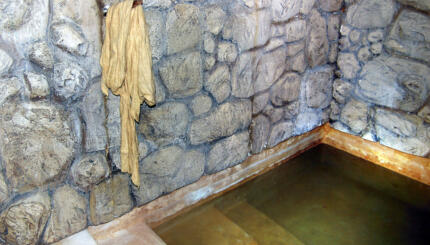Commentary on Parashat Metzora, Leviticus 14:1 - 15:33
The first signs of tzaraat [a disease often translated as leprosy] must be examined carefully. Tzara’atis the collective name for afflictions that attack the body, clothing or house; the usual translation of “leprosy” is inaccurate. Tzara’at is a source of tum’ah (a hard word to translate as well; the best we might say is “spiritual defilement” determined by physical conditions), and requires purification (taharah).
The rabbis teach that Hashem cursed tzara’at on one whose character is flawed by, for example, speaking ill of others or selfishness (Tractate Arachin 15-16). At first his house is affected, then his clothing, and only after these manifestations is his body afflicted. Tzara’atis a “good pain,” punishing him at a stage when these faults can still be rectified.
House-Tzaraat
First comes house-tzaraat:
When you will come to the land of Canaan which I give to you for a possession, and I will put the plague of tzara’at in a house of the land of your possession. And he to whom the house belongs shall come and tell the priest, saying: ‘Something like a plague has appeared to me in the house.’ Then the priest shall command that they empty the house, before the priest comes to view the plague, so that all that is in the house be not made tamei (spiritually defiled); then afterwards the priest shall come to view the house (Vayikra 14:34-36).
With your help, My Jewish Learning can provide endless opportunities for learning, connection and discovery.
Rashi refers to the Mishnah (Nega’im 12:5): Even if the owner of the house who notices the signs is a scholar, and is able to determine with certainty that this is tzara’at, he may not state categorically “nega” — “A plague has appeared to me in the house,” but rather “k’nega” — “Something like a plague has appeared to me in the house.” The Rambam codifies this in the Laws of the Uncleanness of Tzara’at (14:4).
Why dilute the truth? As the Siftei Chachamim (Shabbetai Bass, 1641-1718) points out, at first the Torah says, “and I will put the plague of tzara’at,” which indicates certainty. So, why should the Torah now insist on the words of uncertainty, “Something like a plague?”
However, even if the owner of the house were to make a definitive statement, it would have no effect, because, as the Mishnah teaches (Nega’im 3:1), “Uncleanness and cleanness are in the power of the Kohen (priest):” the Kohen tells him whether to declare “tamei,” and only then does the house become tamei. The Kohen’s proclamation is intrinsic to the creation of reality. All the owner does is provide the basis for creating that reality.
This leads to the question asked by R. Eliyahu Mizrachi (c.1450-1526): Why must the owner say “k’nega?” After all, prior to the Kohen’s proclamation there is no tum’ah. So, what harm would there be in the owner saying “nega?” Whatever he says will not change the situation anyway!
A comprehensive summary of the major points of view in this question is presented by R. Yom Tov Lipmann Heller (1579-1654) in his commentary Tosefot Yom Tov on the Mishnah. He discusses five opinions:
1. R. Mizrachi quotes his teachers: The Torah is teaching a lesson in proper behavior (derech eretz), to speak with reservation and humility, even when the situation looks unequivocally clear. As the Talmud says, “Teach your tongue to say ‘I do not know’” (Tractate Berachot 4a).
2. R. Mizrachi himself suggests two answers. First: Since the Kohen is the only one to determine whether or not the house is unclean, for anyone else to say so would be disrespectful towards the position of the Kohen. This is similar to the prohibition against a student, even a very knowledgeable one, rendering a halachic (Jewish legal) decision in the presence of his teacher (Tractate Sanhedrin 5b).
3. R. Mizrachi’s second answer is that the Kohen should not be rushed into making his proclamation. By the owner saying “k’nega,” he is taking some of the pressure off the Kohen.
4. Gur Aryeh (R. Yehudah Loew ben Betzalel, the Maharal of Prague, c. 1525-1609) states: The owner may not say, “A plague,” simply because it is not true. Until the Kohen proclaims it tamei, it is not a plague, and must not be spoken of as such, because “He that tells lies shall not remain” (Psalms 101:7).
5. Korban Aharon (R. Aharon ben Avraham ibn Chayim; 1545-1632) comments: When the symptoms of tzara’at appear in the house, it is a plague, but it does not attain the status of tamei until the Kohen declares it so. Meanwhile, however, it is still possible that the plague will dim and the Kohen will then proclaim tahor. At this stage, the owner is enjoined, “Do not open your mouth to the Satan” (Tractate Berachot 19a): do not foreshadow a worst-case scenario.
Another Question
One question remains: Why doesn’t this insistence on saying k’nega also apply to body-tzara’at or clothing-tzara’at? Tosefot Yom Tov notes that house-tzara’at is the first stage in the process. Once the clothing or body has been afflicted the die has been cast and it’s too late.
Perhaps here we can incorporate the idea from the Korban Aharon. At this unresolved stage between k’nega and nega, all is not lost. In fact, Hashem is doing the owner of the house a favor by making him aware of a fault in his character. This seeming-plague is an alarm bell, a wake-up call to repentance. Now is not the time to take a negative attitude, but to welcome the warning before matters deteriorate.
From this one halacha (law), we gain many insights into the values that must suffuse Torah learning:
Pursue truth with humility.
Respect those in positions of honor.
Make decisions without haste.
Be accurate.
Remain open to positive results.
Be ready for initiatives to self-improvement.
Be careful with each word.
All this from “k’nega!” How much can be learned from just one letter!
Provided by the Orthodox Union, the central coordinating agency for North American Orthodox congregations.
Aharon
Pronounced: ah-ha-RONE, Origin: Hebrew, Aaron in the Torah, brother of Moses.
Avraham
Pronounced: AHVR-rah-ham, Origin: Hebrew, Abraham in the Torah, considered the first Jew.
Mishnah
Pronounced: MISH-nuh, Origin: Hebrew, code of Jewish law compiled in the first centuries of the Common Era. Together with the Gemara, it makes up the Talmud.
Talmud
Pronounced: TALL-mud, Origin: Hebrew, the set of teachings and commentaries on the Torah that form the basis for Jewish law. Comprised of the Mishnah and the Gemara, it contains the opinions of thousands of rabbis from different periods in Jewish history.
Torah
Pronunced: TORE-uh, Origin: Hebrew, the Five Books of Moses.


